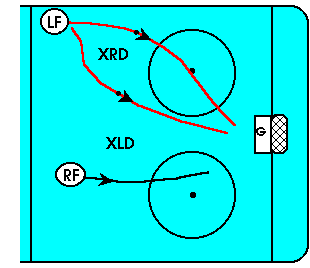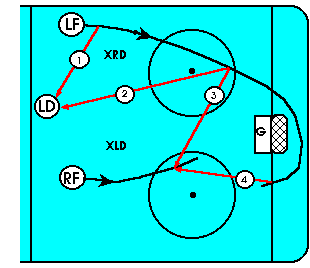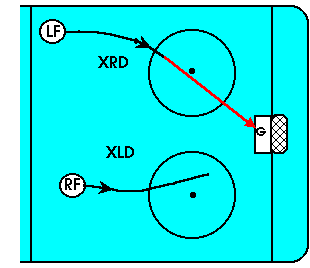Offensive Attacking (Part 1) -- by Greg Siller
An offensive zone attack is really a two stage process; the first stage involves moving
the puck into the offensive zone, while the second stage consists of maintaining the puck
in the offensive zone. Part 1 of this 2 part article covers moving the puck into the
offensive zone.
Scoring goals should be based on an overall offensive zone strategy. To be effective, this
strategy should incorporate the following six factors:
- Puck control and movement. Opportunities are created by the puck carrier
moving and constantly looking to pass, shoot, or skate to the net.
- Positioning of non-puck carrying players with respect to the puck carrier/shooter.
Supporting players should make themselves available to receive a pass, clear an area to
allow space for the puck carrier, screen an opponent, and offer close support to the puck
carrier.
- Defined plays with improvisation. By working on defined offensive plays,
the players develop the confidence and ability to improvise on the defined plays when
different situations arise.
- Shots on net from a high percentage scoring location. Move the puck from
the perimeter scoring areas toward the slot so that a direct shot, screen shot, or
deflection can be executed. After the initial shot, there is always the potential for a
second opportunity; a rebound. Remember that each shot is really a potential one-two
punch; the initial shot and the rebound.
- Patience by the offensive team, especially the puck carrier, is required
to make effective use of puck control. Since your team has control of the puck, why be
quick to get rid of it?
- Reading, reacting, and anticipating. All offensive players should know the
tendencies of their teammates as well as learn the opponent's defensive strategies and
incorporate this information into the overall offensive zone strategy.
Three techniques that a team can use to initially move the puck into their offensive
zone consist of skating, passing, or shooting.

In the first figure, the two circled attackers move toward the net. Employing the skating
attack, the puck carrier (LF) can choose to put on a burst of speed and move to the
outside of the defender (XRD) or execute a body or puck fake and move to the inside of the
defender and straight to the net. LFs teammate (RF) will need to read the puck carriers
movements and react by positioning himself for a pass or rebound. LF should also consider
the space behind the net when initiating this attack.

In the second figure, the three circled attackers move toward the net. Employing the passing
attack, the puck carrier (LF) can choose to:
1) pass to the trailing defenseman (LD) before moving past the defender (XRD);
2) pass to LD just after moving past XRD;
3) pass to RF just after moving past XRD; or
4) skate with the puck behind the net and pass to RF (or LD) near the slot. This last
option is good because it forces the goaltender to move from post-to-post and look behind
the net. A quick pass to the slot just might catch the goaltender off-guard or
out-of-position.

The shooting attack can be used if your teammate is covered, the goaltender is
leaving a portion of the net open, or the goaltender easily gives up rebounds. As LF moves
to the outside of the defender (XRD), he can shoot the puck at an open area on net or
shoot the puck along the playing surface right at the goaltenders stick. This type of
shot, executed from an angle, will generally result in a rebound into, or near, the slot.
RF should always be ready to grab the rebound and put it home!
Choosing the most appropriate technique to penetrate the offensive zone will not ensure
your teams' success, it's how that technique is implemented (using the six offensive zone
strategy factors) that will ensure success.


